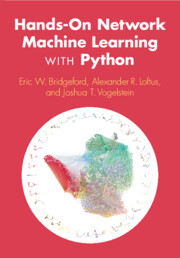Refine search
Actions for selected content:
2350 results in Statistical theory and methods
Game-Theoretic Models of International Crisis Bargaining
- Coming soon
-
- Expected online publication date:
- July 2026
- Print publication:
- 31 July 2026
-
- Book
- Export citation
Developing Theories in the Social Sciences
- Methods and Applications
- Coming soon
-
- Expected online publication date:
- June 2026
- Print publication:
- 30 June 2026
-
- Book
- Export citation
All of Regression
- Coming soon
-
- Expected online publication date:
- June 2026
- Print publication:
- 30 June 2026
-
- Book
- Export citation
Inference in Statistical Modelling and Machine Learning
- A Concise Introduction
- Coming soon
-
- Expected online publication date:
- May 2026
- Print publication:
- 31 May 2026
-
- Book
- Export citation

A Practical Guide to Time Series Analysis
- Coming soon
-
- Expected online publication date:
- March 2026
- Print publication:
- 31 March 2026
-
- Book
- Export citation

Hands-On Network Machine Learning with Python
-
- Published online:
- 23 September 2025
- Print publication:
- 18 September 2025
Preface
-
- Book:
- Hands-On Network Machine Learning with Python
- Published online:
- 23 September 2025
- Print publication:
- 18 September 2025, pp ix-xvi
-
- Chapter
- Export citation
Frontmatter
-
- Book:
- Hands-On Network Machine Learning with Python
- Published online:
- 23 September 2025
- Print publication:
- 18 September 2025, pp i-iv
-
- Chapter
- Export citation
Appendix B - Learning Representations Theory
-
- Book:
- Hands-On Network Machine Learning with Python
- Published online:
- 23 September 2025
- Print publication:
- 18 September 2025, pp 433-453
-
- Chapter
- Export citation
4 - Statistical Models of Random Networks
- from Part II - Representations
-
- Book:
- Hands-On Network Machine Learning with Python
- Published online:
- 23 September 2025
- Print publication:
- 18 September 2025, pp 98-188
-
- Chapter
- Export citation
6 - Applications for a Single Network
- from Part III - Applications
-
- Book:
- Hands-On Network Machine Learning with Python
- Published online:
- 23 September 2025
- Print publication:
- 18 September 2025, pp 259-310
-
- Chapter
- Export citation
Index
-
- Book:
- Hands-On Network Machine Learning with Python
- Published online:
- 23 September 2025
- Print publication:
- 18 September 2025, pp 456-460
-
- Chapter
- Export citation
7 - Applications for Two Networks
- from Part III - Applications
-
- Book:
- Hands-On Network Machine Learning with Python
- Published online:
- 23 September 2025
- Print publication:
- 18 September 2025, pp 311-356
-
- Chapter
- Export citation
Appendix A - Network Model Theory
-
- Book:
- Hands-On Network Machine Learning with Python
- Published online:
- 23 September 2025
- Print publication:
- 18 September 2025, pp 411-432
-
- Chapter
- Export citation
2 - End-to-End Biology Network Machine Learning Project
- from Part I - Foundations
-
- Book:
- Hands-On Network Machine Learning with Python
- Published online:
- 23 September 2025
- Print publication:
- 18 September 2025, pp 19-40
-
- Chapter
- Export citation
1 - The Network Machine Learning Landscape
- from Part I - Foundations
-
- Book:
- Hands-On Network Machine Learning with Python
- Published online:
- 23 September 2025
- Print publication:
- 18 September 2025, pp 3-18
-
- Chapter
-
- You have access
- Export citation
Part II - Representations
-
- Book:
- Hands-On Network Machine Learning with Python
- Published online:
- 23 September 2025
- Print publication:
- 18 September 2025, pp 41-42
-
- Chapter
- Export citation
5 - Learning Network Representations
- from Part II - Representations
-
- Book:
- Hands-On Network Machine Learning with Python
- Published online:
- 23 September 2025
- Print publication:
- 18 September 2025, pp 189-256
-
- Chapter
- Export citation
Part I - Foundations
-
- Book:
- Hands-On Network Machine Learning with Python
- Published online:
- 23 September 2025
- Print publication:
- 18 September 2025, pp 1-2
-
- Chapter
- Export citation
Appendix C - Overview of Machine Learning Techniques
-
- Book:
- Hands-On Network Machine Learning with Python
- Published online:
- 23 September 2025
- Print publication:
- 18 September 2025, pp 454-455
-
- Chapter
- Export citation
